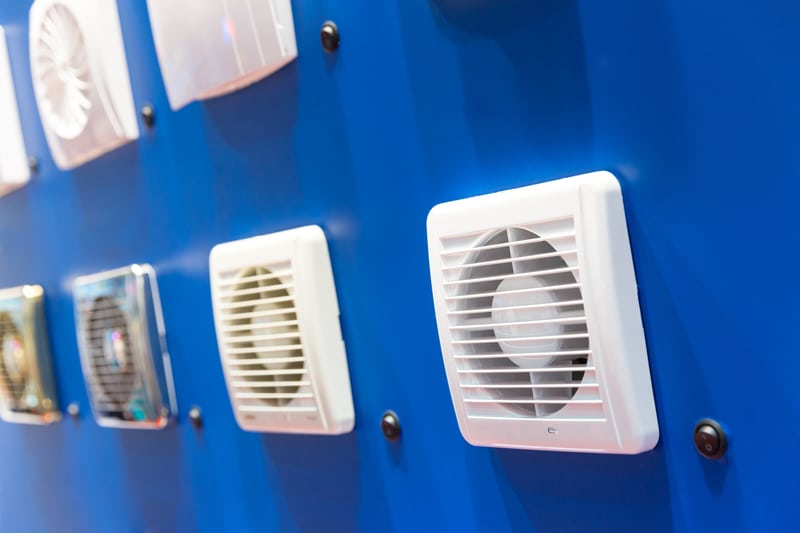
Have you ever started to clean your bathroom or laundry, only to discover a patch of mould growing along the wall?
That’s a common problem in these rooms, especially if you don’t have enough ventilation.
Since your bathroom and laundry produce a lot of moisture every time you take a shower or wash a load of clothes, these rooms become the perfect place for mould to grow.
Without adequate ventilation to dry out the moisture. mould will develop especially on organic materials such as gyprock and fabric materials stored in these areas.
There are several methods to ventilate your bathroom or laundry. In addition to simply opening the windows and installing screens to keep pests out, there are three types of bathroom and laundry exhaust fans: wall-mounted, ceiling-mounted, and inline.
Here’s a look at their characteristics.
Although this method will keep your bathroom and laundry dry during hot, dry weather, it’s not the most energy efficient method, nor will it work during rainy, humid or cold weather. If you keep your windows open during the winter, the loss of heat will cause you to use a lot more energy to heat your home.
Similarly, even during hot, dry weather, this method isn’t at all practical, since your air conditioning system will work overtime to cool your home, and can lead to higher energy bills.
Though opening your windows won’t require installing anything more expensive than a screen, it may cost your more in energy costs in the long run.
And, it won’t work during rainy or humid weather, when mould can grow uninhibited since the incoming air will be humid, too.
One of the best choices for a first-floor bathroom or laundry in a two or more level building, a wall-mounted fan mounts onto the external wall of your home. It vents directly through the wall to the outside.
In colder, windy, or wet climates, wall exhaust fans can be an advantage, particularly if the bathroom is directly opposite an exterior wall. In addition, there is one fewer opening on the roof, reducing the chance of water leaks.
However, they do have their downsides. Since they have a direct link to the outdoors, there is the chance that they can cause heat loss or even incoming cold air.
Also, unless you install it near the ceiling, it’s not as effective at removing the moist, warm air that rises to the ceiling.
Ceiling-mounted fans mount onto or into the ceiling. They vent through the roof space and out through the roof via ductwork.
We do not recommend venting your exhaust fan into the roof space only.
Since they mount on the ceiling and carry the air upward into the roof cavity, ceiling fans are quieter than wall-mounted bathroom fans.
They’re also especially a good choice for bathrooms on the top floor since the ductwork can take up extra space on the lower floors.
You can also incorporate a ceiling-mounted fan into a specially designed light fixture.
Inline exhaust fans are installed inside the ceiling cavity. We normally mount them between lengths of ductwork.
Inline fans often produce less noise since the fan is located inside the roof or ceiling cavity, away from the room itself.
Inline fans come with a variety of motors: axial, centrifugal, and mixflow. Centrifugal motors are the most powerful of the three.
Installers use these in situations in which you have lengthy ductwork so the air can make its way through the ducts to the outdoors.
Axial motors work well with more direct ductwork since they operate at a lower pressure.
Mixflow motors blend the two types and are suitable for medium lengths of ductwork or shorter lengths with bends or branches.
Spa bathrooms and showers usually need 15 air changes per hour. Toilets might only require ten.
After you’ve measured your room, multiply the result by 15, which will give you the capacity rating (in cubic metres per hour) you need for your space.
Laundries without a dryer require about the same capacity rating as toilets, unless the space is prone to condensation. Laundries with dryers require approximately the same capacity rating as showers and spa baths.
In addition to getting the capacity rating, the noise level, and the energy consumption you want in your bathroom or laundry ventilation system, you need to consider aesthetic and functional factors—especially in a bathroom.
Consider the overall style of the space. Today’s fans include a wide variety of styles, including industrial, contemporary, and traditional.
Choosing a colour and style that blends with the rest of the room creates a seamless look.
With proper design from the outset, you can prevent mould growth ever from getting a foothold in your bathroom or laundry.
If you have an existing mould problem, ventilation is the key to ridding your home of it for good.
To learn more about the best way to prevent mould through adequate ventilation–or to arrange a mould inspection for your home, get in touch with the mould removal experts at PureProtect today.
PureProtect Pty Ltd © 2020. All rights reserved